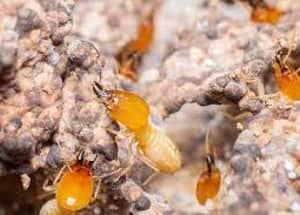Termite Diets: What Do Termites Eat?
In this section, we will discuss the different diets that termites consume and how it affects them. To learn more about termite feeding habits and patterns, continue reading or click here.
Cellulose-Based Diets
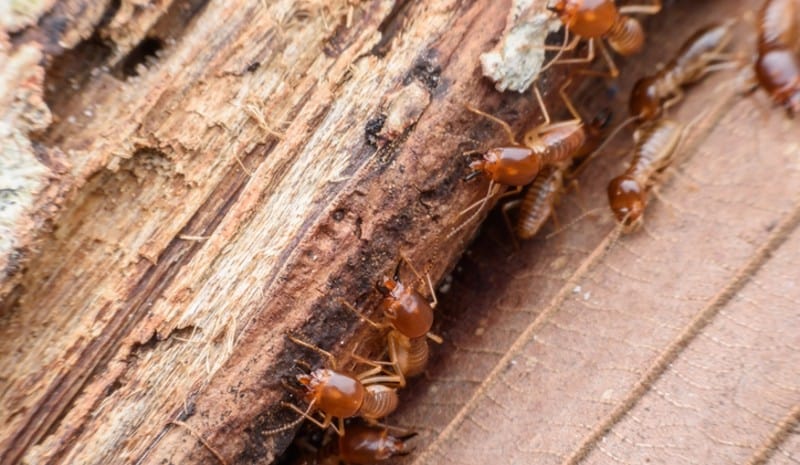
Termites are known for their ability to cause significant damage to wooden structures. This is because wood is one of the primary food sources for termites. However, they don’t actually eat the wood directly. Instead, they feed on the cellulose that makes up the wood. Cellulose is a complex carbohydrate that provides termites with energy and nutrients.
Termites can consume a variety of wooden structures, including but not limited to:
| Wooden Structures | Description |
|---|---|
| Foundation walls | Termites can damage the wooden framing and insulation in foundation walls, leading to structural weakness. |
| Roofing and Floorboards | Termites can chew through roofing shingles as well as the wooden floorboards that support a building’s weight, causing irreparable structural problems if the damage goes unnoticed. |
| Fences and Decks | Termites can significantly destroy outdoor structures such as fences and decks, both of which should be regularly inspected and treated for pests to prevent damage. |
It’s important to note that termites don’t just eat wood. They can also feed on other organic materials, such as drywall, paper, and cardboard. Homeowners should also monitor their decorative objects for signs of termite infestation.
In addition to causing physical damage to wooden structures, termite activity can also lead to costly repairs. If left untreated, termite damage can weaken a building’s structure, leading to potential safety hazards and expensive repair bills.
Termites have developed several adaptations to acquire the necessary nutrients from cellulose-based diets. Termites rely on symbiotic relationships with microorganisms in their gut to digest cellulose. These microorganisms break down cellulose into simple sugars which the termite can absorb and utilize. This means that termites are capable of breaking down and digesting cellulose-based diets that most other animals cannot. To learn more about termite feeding patterns and gut microbes’ role in digestion, please visit termite feeding patterns and gut microbes and termite digestion.
Termites’ diet behavior can significantly impact their surroundings. They tend to focus on sources of cellulose, which can cause significant damage to wooden structures and other wooden furnishings. This leads to the modification of the landscape, which can have far-reaching effects. To learn more about the effects of termite diets on landscapes and structures, please visit termite landscape modification.
Understanding the different types of cellulose-based diets that termites consume is crucial in preventing and controlling termite infestations. By removing or reducing the availability of cellulose-based food sources, you can effectively control termite populations. To learn more about termite diets’ impact and behavior on control strategies and prevention tips, please visit termite diet behavior and impact.
To avoid costly repairs, it’s important to detect termite activity early on. Regular inspections by a pest control professional can detect termite activity and prevent damage to wooden structures. Homeowners can also take preventative measures, such as sealing cracks and crevices in wooden structures, reducing moisture levels, and eliminating sources of termite food.
Non-Cellulose Diets
Termites are primarily known for feeding on cellulose-based diets, but they are also capable of digesting a variety of non-cellulose materials. Some of the non-cellulose materials that termites feed on include fungi, lichens, and other organic matter. Additionally, some species of termites have been known to feed on animal dung, which contains a significant amount of nutrients.
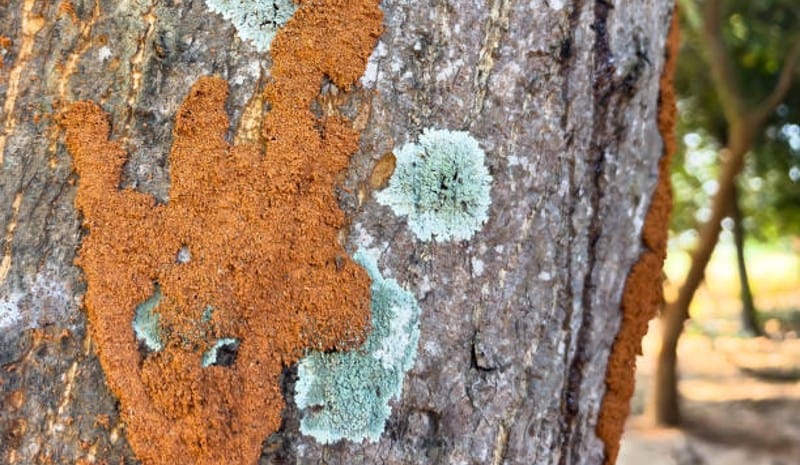
Fungi: Many species of termites feed on fungi. In fact, some termite species have evolved a mutualistic relationship with fungi, in which the termites provide the fungus with food and the fungus helps the termites digest cellulose. These fungi are cultivated by termites in special structures called fungus gardens. The termites feed the fungi with bits of cellulose and other organic matter and in return, the fungi produce enzymes to break down the cellulose, which the termites then consume.
Lichens: Some termite species also feed on lichens, which are symbiotic organisms made up of a fungus and a photosynthetic partner, usually an alga. Lichens have a high nutritional value and are easily digested by termites. In fact, studies have shown that termites can consume up to 90% of the lichen biomass in certain ecosystems.
Animal Dung: Certain termite species are known to feed on animal dung, which contains a large amount of nutrients. The termites consume the dung and break it down into smaller particles, which are then used as a food source.
It is important to note that while termites are capable of digesting non-cellulose materials, their diet still consists primarily of cellulose-based material. Termites cannot survive on non-cellulose diets alone, and their ability to digest non-cellulose materials is thought to have evolved as a supplementary food source during times of scarcity.
To learn more about the nutritional value of cellulose-based diets in termites, check out our article on termite cellulose nutrition.
Factors That Affect Termite Diets
When it comes to understanding termite diets, there are a few factors that come into play. It’s not as simple as just knowing which types of food sources termites prefer. Environmental conditions, location and species, population size and age – all of these elements have an impact on the diets of termites. It’s important to take a closer look at each of these factors in order to get a more comprehensive understanding of what termites are eating and why. Let’s dive into the details and explore the various influences on termite diets.
Environmental Conditions
The environmental conditions play a significant role in determining the termite diets. The availability of food sources and the moisture in the environment are two main environmental factors that can influence termite feeding habits. Termites require moist conditions to survive and thrive, and they prefer to feed on wood that contains a high moisture content.
Here are some of the environmental conditions that can affect termite diets:
- Moisture: As mentioned earlier, the presence of moisture is crucial for termite survival. Termites prefer to feed on moist wood, and they often construct their nests in damp soil or wood. Areas with high humidity and rainfall can provide suitable environments for termite populations to grow.
- Temperature: Different species of termites have different temperature preferences. Some species thrive in warmer climates, while others prefer cooler environments. The ideal temperature range for most termites is between 75 and 95 degrees Fahrenheit.
- Soil Type: The type of soil in an area can also determine the availability of food sources for termites. Soil that is rich in organic matter, such as clay or loam, can provide a steady supply of cellulose-based materials like plants and dead wood, which are the primary food sources for termites.
- Vegetation: The vegetation in an area can also influence termite diets. Termites often feed on plant material like leaves, twigs, and grasses, so areas with high vegetation density can provide abundant food sources for termites. However, they are not limited to green plants as dietary sources, and will feed on decaying organic matter as well.
- Proximity to Water: Termites require water to survive, and their proximity to a water source can dictate their feeding habits. Areas near bodies of water, such as ponds, lakes, and streams, can provide a steady source of moisture for termites.
These environmental factors can directly impact the availability and type of food sources that termites have access to. It is essential to consider them when devising termite prevention and control strategies.
Location and Species
The location and species of termites play a significant role in their diet. Different termite species thrive in varying environments, and their diets often reflect this. Termites that live in dry and arid regions usually feed on wood and leaves, while those living in damp areas feed on grasses and other plants. Additionally, some species of termites are known for feeding on animal matter.
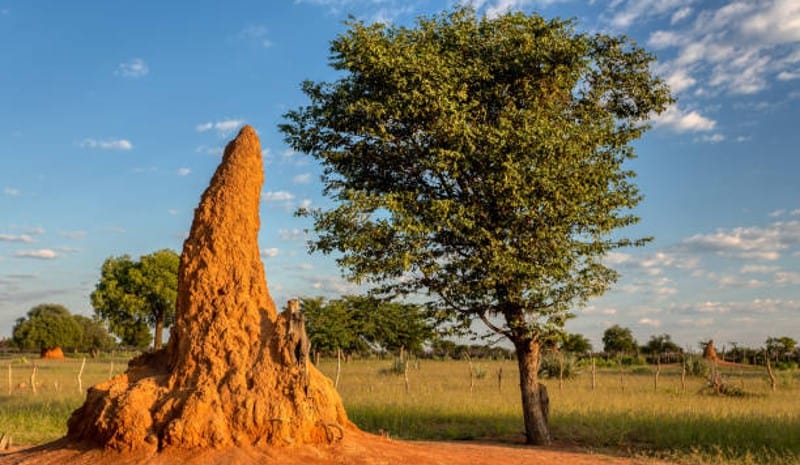
Termites in Dry Regions:
- These termites typically feed on wood and dry leaves.
- They can go for long periods without water.
- Some common species include drywood termites and desert termites.
Termites in Damp Regions:
- These termites feed on grasses, shrubs, and other plants.
- They require regular moisture to survive.
- Some common species include conehead termites and dampwood termites.
Termites That Feed on Animal Matter:
- These termites feed on dead animals and other organic matter.
- Some common species include the harvester termite and the termite-eating ant.
It’s important to note that the location of a termite colony can also affect its diet. For example, a colony located near a food source like a wooden structure may primarily feed on that structure. In contrast, a colony located far away from a food source may have a more diverse diet.
Understanding the location and species of termites is essential when devising a termite control and prevention plan. By knowing what types of termites are present and what they feed on, property owners can take the necessary steps to safeguard their structures and landscaping from termite damage.
Population Size and Age
The population size and age of a termite colony can also have an impact on their diet. A younger colony may focus more on building their infrastructure and may not consume as much food as an older, more established colony. However, as a colony grows in size and ages, their dietary needs will change.
Population size: A larger colony will require more food to sustain itself, and termites will need to consume greater quantities of their preferred food sources. In fact, an average-sized termite colony can consume up to a pound of wood per day, making even small infestations a cause for concern.
Age: As a colony ages, it may shift its focus from wood to other food sources such as crops or plants. This is because older termites may have a harder time digesting complex carbohydrates found in wood and need to switch to less complex carbohydrate sources. Additionally, older termite colonies may have already consumed all available wood in their immediate vicinity, necessitating a shift to new food sources.
Other factors such as environmental conditions and termite species can also play a role in determining their preferred diet. Understanding these factors can help identify and prevent potential infestations and keep your property safe.
Termites as Agricultural Pests
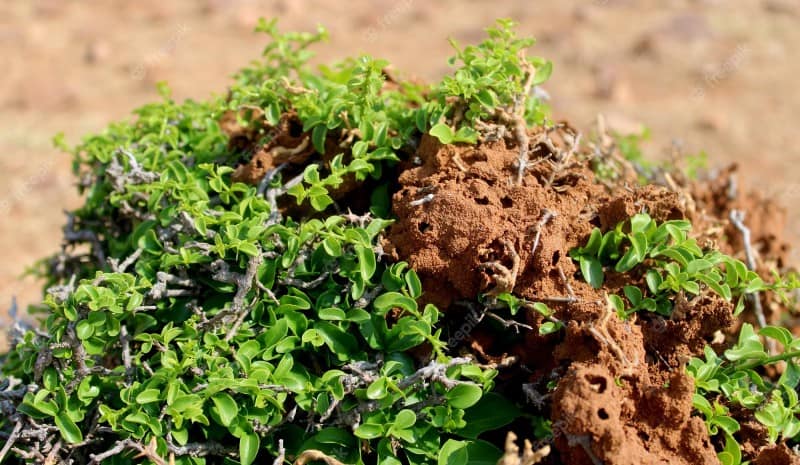
Termites are not only a nuisance in residential and commercial structures but also in agricultural areas. These tiny insects have a big appetite for cellulose and other plant-based materials, making them a significant threat to crops and vegetation. Their ability to cause severe damage to plants and trees poses a challenge to farmers and gardeners, who rely on productive yields. Let’s explore how termites can cause agricultural damage and what measures can be taken to prevent and control their destructive behavior.
Different Types of Agricultural Damage
Termites cause extensive damage to agricultural crops and can destroy entire fields if left unchecked. Here are some different types of agricultural damage caused by termites:
- Root damage: Termites feed on plant roots, which weakens the plant and may cause it to wilt or die. This can lead to significant crop loss, especially in the case of subsistence farming.
- Stem damage: Termites can bore into the stems of plants, creating holes and compromising the structural integrity of the plant. This may lead to the plant breaking or falling over, which can be disastrous for crops like corn, wheat and rice.
- Leaf damage: While termites don’t typically eat leaves, they may feed on the leaf sheaths and cause discoloration or an unusual drying out of the leaves.
- Seedling damage: Termites can be especially damaging to young plants that are still growing. They may eat the seeds or seedlings, preventing new growth from taking place.
- Soil damage: Termites can also damage the soil in which crops are grown. Their tunneling activities can alter the soil structure and composition, leading to decreased fertility and water-holding capacity.
The cost of termite damage to agriculture can be staggering, both in terms of crop loss and the cost of pest control measures. In some parts of the world, termites are a significant threat to food security and livelihoods. It’s important to take steps to prevent termite infestations before they cause irreparable harm.
Prevention and Control Measures
Implementing prevention and control measures is essential to minimize the damage caused by termites. Let’s take a closer look at some of these measures and how they can help protect your property.
| Prevention and Control Measures | Description |
|---|---|
| 1. Soil Treatment | Applying a chemical barrier around your property can prevent termites from entering or feeding on your wooden structures. This treatment involves digging a trench around the perimeter of your property and applying a liquid chemical that can kill termites on contact. This can be an effective long-term solution for termite prevention. |
| 2. Baiting Systems | Taking advantage of the termites’ feeding habits, baiting systems can be installed around your property to attract and kill termites. These baits can be more environmentally friendly than traditional chemical treatments, as they target the termites specifically and pose no risk to other organisms. Regular monitoring is required to ensure the effectiveness of the baiting system. |
| 3. Physical Barriers | Physical barriers such as metal mesh or sand barriers can be installed around your property to prevent termite entry. These barriers make it difficult for termites to access your wooden structures and can be an effective prevention measure. However, they must be installed correctly and continuously maintained to ensure effectiveness. |
| 4. Moisture Control | Termites require moisture to survive, so keeping your property dry and well-ventilated can prevent infestations. This can be achieved by fixing any leaky pipes, addressing drainage issues, and ensuring proper ventilation throughout your property. |
| 5. Chemical Treatments | Chemical treatments involve the use of pesticides or insecticides that can kill or repel termites. These treatments can be effective, but they must be applied correctly and safely. It is recommended to hire a professional pest control service to ensure safe and effective application. |
| 6. Regular Inspections | Regular inspections by a pest control professional can detect termite activity early and prevent extensive damage. It is recommended to have your property inspected at least once a year and more frequently if you live in an area with high termite activity. |
By implementing these prevention and control measures, you can effectively protect your property from termite damage. However, it is important to take a proactive approach and regularly monitor and maintain these measures to ensure their effectiveness.
Conclusion
As we conclude our comprehensive guide to termite diets, it is clear that these tiny pests are capable of inflicting serious damage to homes, businesses, and agricultural fields. Termites play an essential role in breaking down cellulose-based materials and recycling them into the ecosystem. However, when their diets include wooden structures and other non-sustainable sources, they become a destructive force.
It is important to understand that termites have diverse diets that vary depending on their species, location, and age. Cellulose-based diets are the most common, but termites also feed on a variety of other materials, such as fungi and animal waste. Environmental conditions, such as moisture and temperature levels, also play a crucial role in determining termite diets.
Nevertheless, as humans, we have a responsibility to protect our properties from termite damage. Preventative measures, such as regular inspections and moisture control, can help reduce the risk of infestations. Effective termite control strategies, such as chemical treatments and professional pest control services, can help eradicate infestations and prevent future ones.
In conclusion, understanding what termites eat is just one piece of the puzzle in protecting ourselves from their damage. By taking necessary precautions and using effective control strategies, we can mitigate the impact of these voracious little creatures and preserve our homes, businesses, and agricultural fields for generations to come.
Frequently Asked Questions
What is the main food of termites?
The main food of termites is cellulose, which is found in wood and plant materials.
Do termites eat concrete or metal?
No, termites do not eat concrete or metal. They only feed on materials that contain cellulose, such as wood and paper.
Why do termites eat wood?
Termites eat wood because it is a source of cellulose, which provides them with the nutrients they need to survive and reproduce.
Can termites cause damage other than to wood?
Yes, termites can also cause damage to other materials that contain cellulose, such as paper, cardboard, and certain types of insulation.
Will termites eventually die if they can’t find wood to eat?
Termites will not necessarily die if they can’t find wood to eat. They are capable of surviving on other cellulose-rich materials and can also feed on fungi and bacteria.
How can I prevent termites from infesting my home?
Some ways to prevent termites from infesting your home include reducing moisture levels and eliminating sources of wood around your property, such as old stumps or woodpiles.
What should I do if I think I have a termite infestation?
If you suspect a termite infestation, it’s best to contact a professional pest control service. They can assess the extent of the infestation and recommend the best course of action.
Can I get rid of termites without using chemicals?
Yes, there are non-chemical methods for getting rid of termites, such as using heat treatment or nematodes. However, these methods may not be as effective as chemical treatments.
Are there any natural predators of termites?
Yes, some animals that prey on termites include ants, birds, and certain types of lizards.
What is the most effective way to control a termite infestation?
The most effective way to control a termite infestation is through a combination of chemical and non-chemical treatments, such as bait stations and soil treatments.

